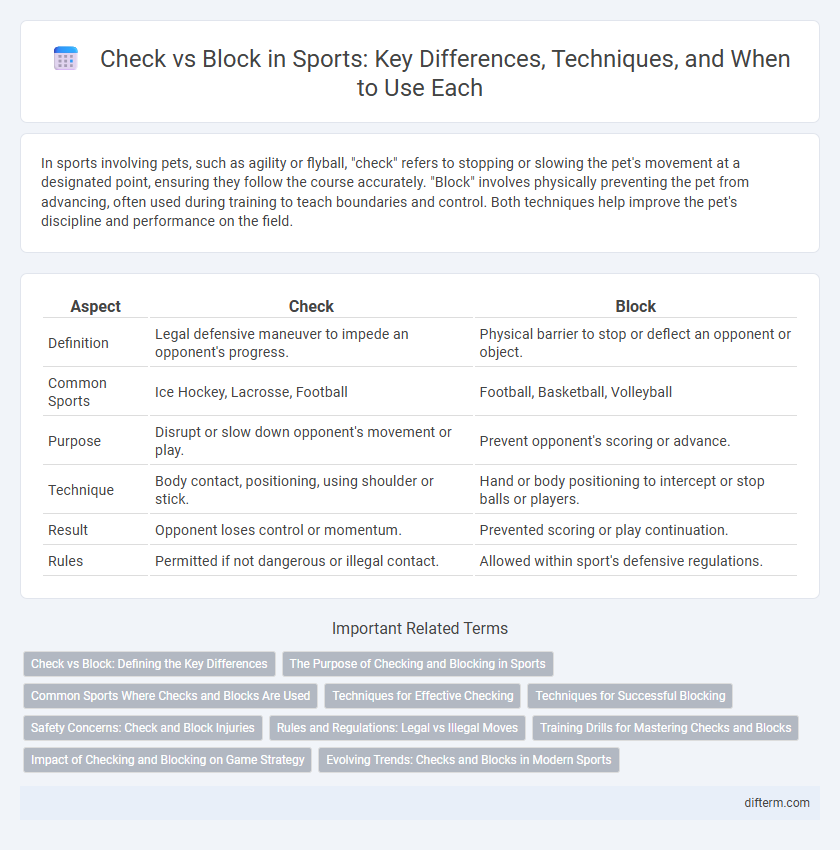In sports involving pets, such as agility or flyball, "check" refers to stopping or slowing the pet's movement at a designated point, ensuring they follow the course accurately. "Block" involves physically preventing the pet from advancing, often used during training to teach boundaries and control. Both techniques help improve the pet's discipline and performance on the field.
Table of Comparison
| Aspect | Check | Block |
|---|---|---|
| Definition | Legal defensive maneuver to impede an opponent's progress. | Physical barrier to stop or deflect an opponent or object. |
| Common Sports | Ice Hockey, Lacrosse, Football | Football, Basketball, Volleyball |
| Purpose | Disrupt or slow down opponent's movement or play. | Prevent opponent's scoring or advance. |
| Technique | Body contact, positioning, using shoulder or stick. | Hand or body positioning to intercept or stop balls or players. |
| Result | Opponent loses control or momentum. | Prevented scoring or play continuation. |
| Rules | Permitted if not dangerous or illegal contact. | Allowed within sport's defensive regulations. |
Check vs Block: Defining the Key Differences
Check in sports like hockey involves using physical contact to disrupt an opponent's play or gain puck possession, often requiring precise timing and positioning. Block refers to intercepting or stopping an opponent's shot or pass without necessarily engaging physically, emphasizing anticipation and defensive positioning. Understanding these distinctions highlights how checks prioritize aggression and control, while blocks focus on protection and prevention within gameplay.
The Purpose of Checking and Blocking in Sports
Checking and blocking serve essential defensive purposes in sports, aiming to disrupt an opponent's control of the ball or puck while maintaining legal play. Checking, commonly seen in hockey, involves body contact to separate the opponent from the puck, forcing turnovers. Blocking, prevalent in basketball and football, is designed to impede or redirect an opponent's movement or shot, protecting teammates and controlling the game's pace.
Common Sports Where Checks and Blocks Are Used
Checks and blocks are fundamental defensive techniques used prominently in ice hockey, lacrosse, and American football to disrupt an opponent's control or advance. In ice hockey, body checks impede players from puck possession, while in lacrosse, stick checks remove or dislodge the ball from an attacker. American football employs blocking to protect the quarterback and create running paths, with different types such as pass blocking and run blocking defining tactical defensive and offensive roles.
Techniques for Effective Checking
Effective checking techniques in sports such as hockey and football emphasize precise timing and body positioning to safely impede an opponent's progress. Utilizing strong shoulder or hip contact while maintaining balance and control minimizes penalties and enhances defensive impact. Proper footwork and anticipation allow players to execute checks that disrupt play without compromising safety or game flow.
Techniques for Successful Blocking
Effective blocking in sports like volleyball and basketball requires positioning the body squarely in front of the opponent to minimize scoring opportunities. Utilizing hand strength and timing is essential to intercept the ball during a shot or pass without committing a foul. Techniques such as maintaining low center of gravity and keeping eyes on the ball improve the likelihood of successful blocks and enhance defensive performance.
Safety Concerns: Check and Block Injuries
Checks and blocks in sports pose significant safety concerns due to their high impact nature, often resulting in concussions, fractures, and ligament injuries. Proper technique and adherence to rules can reduce the risk of traumatic brain injuries and joint damage associated with these actions. Protective gear and rigorous enforcement of penalties for illegal checks and blocks are essential in safeguarding athletes' well-being.
Rules and Regulations: Legal vs Illegal Moves
In sports like hockey and basketball, a check is a legal defensive move involving body contact aimed at gaining possession, while a block involves obstructing an opponent's shot or pass without physical contact. Rules distinguish legal checks, which must be targeted within certain zones and avoid illegal hits such as boarding or charging, from illegal blocks that impede player movement unfairly. Officials enforce penalties for illegal moves to maintain player safety and uphold fair play standards according to governing bodies like the NHL or FIBA.
Training Drills for Mastering Checks and Blocks
Training drills for mastering checks and blocks emphasize proper positioning, timing, and body control to enhance defensive skills in sports like hockey and football. Shadow drills and partner resistance exercises develop muscle memory and reaction speed, crucial for effective checking and blocking. Incorporating video analysis during practice sessions enables athletes to refine techniques and anticipate opponents' movements more efficiently.
Impact of Checking and Blocking on Game Strategy
Checking and blocking significantly influence hockey game strategy by controlling puck possession and player movement. Effective checking disrupts opponent plays and creates turnovers, while strategic blocking reduces shot opportunities and protects the defensive zone. Together, these tactics balance offensive pressure and defensive resilience, shaping team momentum and scoring chances.
Evolving Trends: Checks and Blocks in Modern Sports
Modern sports demonstrate a dynamic shift in the application of checks and blocks, with stricter regulations enhancing player safety while preserving competitive intensity. Advanced analytics reveal that effective blocking techniques contribute significantly to game control and momentum, whereas strategic checking disrupts opponent play and forces turnovers. Training programs increasingly emphasize precision and timing in these actions to reduce penalties and maximize impact within evolving rule frameworks.
check vs block Infographic

 difterm.com
difterm.com